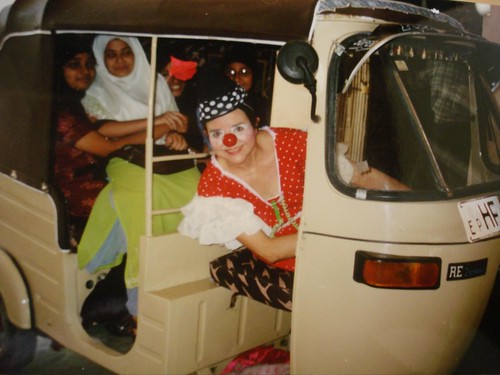lunes, 7 de noviembre de 2011
Versión en Español (Vidas en Movimiento)
Click aquí para ver la versión en Español Vidas en Movimiento http://vidasenmovimiento.blogspot.com/
Contact
The blog Lives in Movement is a collection of stories written by Contemporary Women Travelers.
Contact: livesinmovement@gmail.com
*If you would like to send your story write to this same email address.
Contact: livesinmovement@gmail.com
*If you would like to send your story write to this same email address.
Marina Grayson`s Report

My image of South Africa before I arrived here was the township. When I pictured South Africa, I recalled images I'd seen of the Soweto uprising, the Sharpeville massacre, and the celebrations on the streets of Jo'burg's townships on the day Nelson Mandela became president of a free South Africa. That's what I thought I'd see when I got to Cape Town.
Instead, Cape Town turned out to be a resort town. Central Cape Town is beautiful, clean, and accessible. It was nice, but it felt almost too perfect, too easy. It had no edge. We knew we weren't seeing the "real" Cape Town. We saw only the tiny section of the city squished between the mountains and the ocean. This was the pretty part of town, the white part of town.
The majority of Cape Town's (non-white) residents live in the massive Cape Flats valley, far away from the stunning ocean and mountain views. That's where you'll find the
Townships. That´s the real Cape Town for most people who live here.
Townships are urban residential areas that, under apartheid, were reserved for non-whites. Legislation from the 1950's to 1980's prohibited blacks from living in the cities. Hundreds of thousands of black South Africans moved to neighborhoods outside of the large urban centers, creating squatter communities that eventually turned into highly organized mini-cities. Today, townships remain the primary neighborhoods for South Africa's urban blacks. Though apartheid is now gone, its legacy remains, and is most ...
(click to read the complete report)
Instead, Cape Town turned out to be a resort town. Central Cape Town is beautiful, clean, and accessible. It was nice, but it felt almost too perfect, too easy. It had no edge. We knew we weren't seeing the "real" Cape Town. We saw only the tiny section of the city squished between the mountains and the ocean. This was the pretty part of town, the white part of town.
The majority of Cape Town's (non-white) residents live in the massive Cape Flats valley, far away from the stunning ocean and mountain views. That's where you'll find the
Townships. That´s the real Cape Town for most people who live here.
Townships are urban residential areas that, under apartheid, were reserved for non-whites. Legislation from the 1950's to 1980's prohibited blacks from living in the cities. Hundreds of thousands of black South Africans moved to neighborhoods outside of the large urban centers, creating squatter communities that eventually turned into highly organized mini-cities. Today, townships remain the primary neighborhoods for South Africa's urban blacks. Though apartheid is now gone, its legacy remains, and is most ...
(click to read the complete report)
Photo: Hermanxs en la selva del alto Huallaga
Courtesy of Beatrice Velarde (www.beatricevelarde.com)
miércoles, 16 de febrero de 2011
Carina Watney´s Report
 I would look back fondly on my sheltered childhood memories of Africa with nostalgic reverie, and ten years later, the time had come to return. The sex-crazed drunken beach holidays that plagued my teens was now anathema. This year, I had a tripartite mission: research, internship, and holiday. But I knew that this time if I wanted to learn something I would have to open my mind a bit and heed Achebe’s caveat that “travellers with closed minds can tell us little except about themselves” however difficult it would be to shake off the egocentric hubris that hung like a fardeau around my neck and had conditioned by whole education. My colleague, Karina, an attractive brunette from Canada, and fluent in four languages, met my arrival in Dakar and drove me to meet my host family. My host family lived in the well-to-do residential area of Mermoz. The kitchen was a tiny, primitive mess with two stoves and plastic plates and jugs placed awkwardly on the floor. The broken sink was over-spilling with ...
I would look back fondly on my sheltered childhood memories of Africa with nostalgic reverie, and ten years later, the time had come to return. The sex-crazed drunken beach holidays that plagued my teens was now anathema. This year, I had a tripartite mission: research, internship, and holiday. But I knew that this time if I wanted to learn something I would have to open my mind a bit and heed Achebe’s caveat that “travellers with closed minds can tell us little except about themselves” however difficult it would be to shake off the egocentric hubris that hung like a fardeau around my neck and had conditioned by whole education. My colleague, Karina, an attractive brunette from Canada, and fluent in four languages, met my arrival in Dakar and drove me to meet my host family. My host family lived in the well-to-do residential area of Mermoz. The kitchen was a tiny, primitive mess with two stoves and plastic plates and jugs placed awkwardly on the floor. The broken sink was over-spilling with ...(click to read the complete report)
http://www.mediafire.com/?jw2lavo5xsyr9hw
Suscribirse a:
Entradas (Atom)
 Marta Sanchez, Clown without borders
Marta Sanchez, Clown without borders